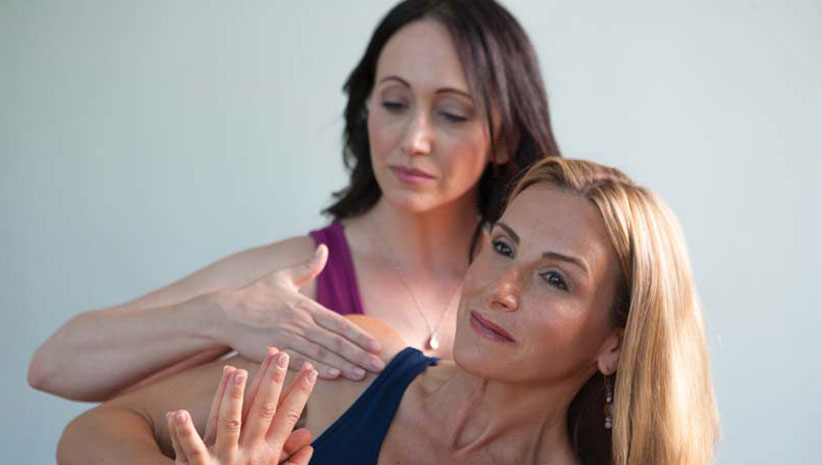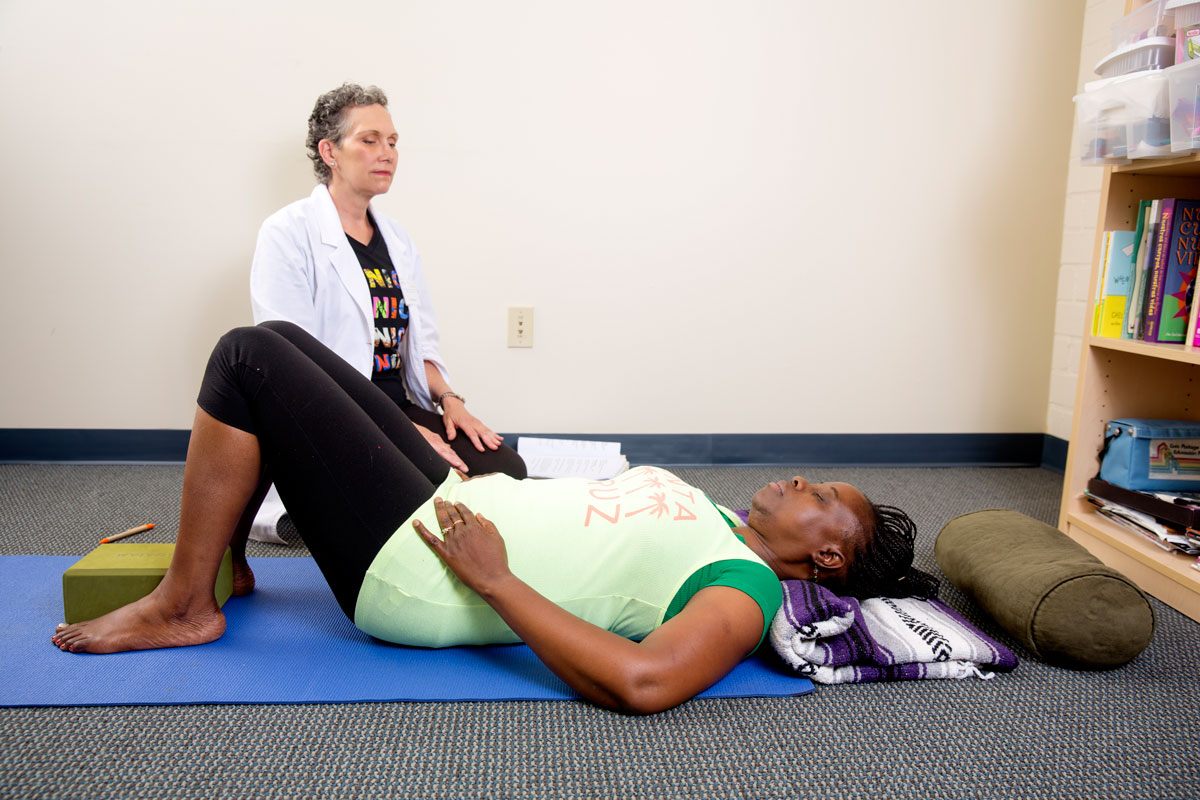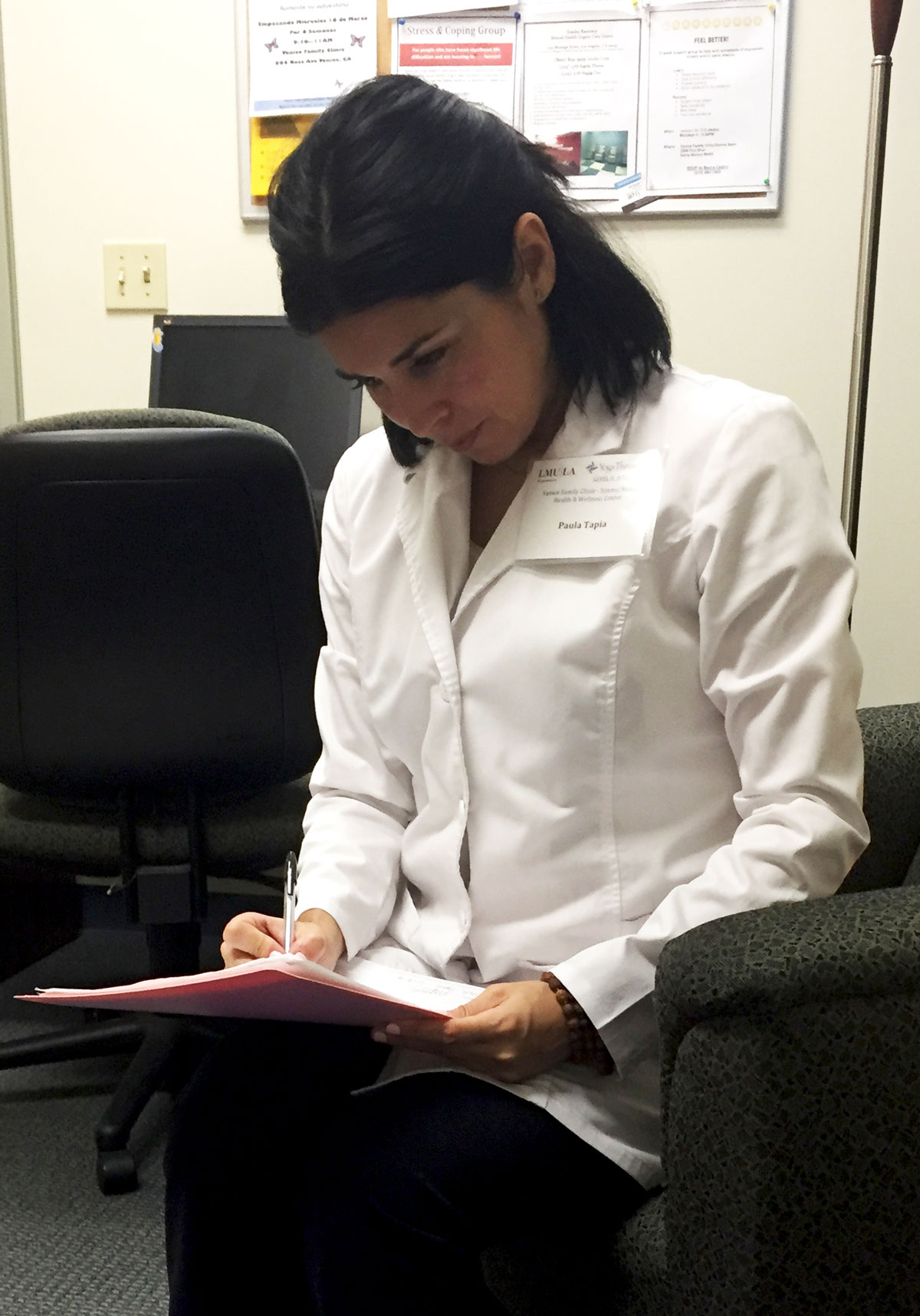
Teachers Lainie Devina and Holli Rabishaw shot by Jeff Skeirik
The term Golden Age refers to a period of time when flourishing and abundance happens within a specific community or society.
The Golden Age of wisdom was around 400 BCE when Socrates charmed the West with profound discourses and The Buddha illumined the noble paths to end suffering in the East. Art experienced its Golden Age in the Renaissance when Leonardo da Vinci’s Mona Lisa made the world fall in love with simplicity and Michelangelo enchanted people’s hearts on the ceilings of the Sistine Chapel.
Although it’s rare to predict a Golden Age before or while in the midst of happening, the times today beg the question: Are we entering a Golden Age in the field of Yoga Therapy?
Yoga Therapy is the philosophy, art, and science of adapting classical Yoga techniques to contemporary situations to support people with physical, mental, and emotional ailments. According to the definition of the International Association of Yoga Therapists (IAYT), “Yoga therapy is the process of empowering individuals to progress toward improved health and well-being through the application of the teachings and practices of Yoga.”
Practically speaking, Yoga Therapy is the reinvention of a personalized Yoga experience where the practice is modified to meet the individual’s ever-changing needs. Since ancient times, adaptability in one’s teaching, practice, and approach has rested at the heart of Yoga’s most fundamental influence: the relationship, insights, and trust created through the practice by one teacher working with one student. Unfortunately, this ideal is sometimes challenging to uphold in the contemporary group class environment that dominates much of modern Yoga culture.
Today, a private Yoga Therapy session is often a quasi-amalgamation of movement science and physical therapy (asana), breathwork and energy cultivation (pranayama), stress reduction therapy (meditation and Yoga Nidra), nutrition (Ayurveda), psychology and behavioral therapy (Yoga sutras), and euphoria (samadhi) all rolled into one.
Sounds great, right?
You’re not alone. Millions of other people think so, too.
The latest long-range market research describing the yoga community, released by Yoga Journal and Yoga Alliance in January 2016, found that the number of people practicing Yoga in the US alone rose from 20 million in 2012 to 36 million in 2016 while industry sales figures increased from $10 billion to $16 billion. It is interesting to note that the largest growing sector within this community are people aged 55 and up. This demographic of yogis jumped 350% from 4 million people to 14 million people in the same four year time period. The 55 and over crowd are currently trying Yoga at the highest rates of any population.
Score #1 for Yoga Therapy’s Golden Age.
Yoga is being practiced by a specific population devoting a large amount of resources to healthy lifestyles.
Esteemed orthopedic doctor and Yoga anatomy expert Ray Long, MD says, “There has been an explosion of interest in practicing Yoga, both for its healing potential and its ability to enhance quality of life.” While many Yoga classes emphasize a competitive atmosphere of ‘pushing to one’s edge” and “exploring one’s physical limitations,” Yoga Therapy, in contrast, accepts practitioners where they are physically and also nurtures their mental, emotional, and spiritual selves. It offers a multi-layered and holistic approach linking the practice, the individual, and one’s lifestyle and environment to create balance or homeostasis—referred to in Yoga Therapy as “a sattvic life.”
What’s more, Yoga Therapy values function over form. Just like a tailor adjusts clothing to fit an individual’s unique shapes and curves, Yoga Therapy tailors the practice to the individual’s, needs, abilities, restrictions/illnesses, aspirations, and goals. This mindful method of personalizing one’s practice cultivates longevity and is integral to prevention.
Taking this into account, the migration of today’s maturing demographic to Yoga as therapy is not surprising.
The current baby boomer population dynamics have created what is known as the “2030 problem” in the scientific literature – which means that by 2030 over 61 million people in the US will be between the ages of 66 – 84 and will require healthcare that addresses their needs.
Think about that for a moment.
Approximately 61 million people in the US alone (likely topping hundreds of millions worldwide) will be over the age of 55 by 2019. This population explosion will be adding, year-by-year, to Yoga’s largest growing and most influential population sector, those 55 and older.

Yoga Therapist Terri Roseman with Student at Venice Family Clinic. Photo by David Young-Wolff.
Score #2 for Yoga Therapy’s Golden Age.
Yoga Therapy has the power to affect and influence millions of people whose evolving needs might otherwise remain underserved or inadequately served by the current healthcare industry.
Collectively, people over 55 are paradigm-shifters who have been part of a number of significant social changes such as civil rights, medical marijuana, single parenting, and gay marriage. This group grew up with The Beatles practicing Transcendental Meditation and Ram Dass encouraging people to Be Here Now. One of the most important social stigmas that the Baby Boomers have removed, which has had the biggest impact on Yoga itself, is that you are weird, strange, or uncool for practicing Yoga.
In today’s world, it is quite the contrary! I dare to say that in 2016 anything Yoga-related is The New Black.
Stylecaster’s picks for 2016 fitness trends includes Eastern medicine, stretching classes, nutritional beauty, inner body wellness, mindful exercise, and holistic happiness. The most popular ways to stay in shape are code for practices and techniques found within the scope of Yoga Therapy.
The Yoga community is even adapting to accommodate.
A variety of approaches to yoga have sprung up to deliver a more Yoga Therapy-esque version to the group class setting including Viniyoga, Silver Age Yoga, Yoga4Seniors, Urban Zen, Chikitsa Vinyasa Yoga (Therapeutic Flow Yoga), and Prime of Life Yoga. Instructors in styles such as Prime of Life Yoga focus on how the practice can prevent osteoporosis, decrease back pain, minimize stress, maintain muscle pliability, and reduce the risk of falls. Elizabeth Visceglia, MD says, “Yoga practice is a low-cost intervention with no significant dangers or side effects when utilized by a knowledgeable practitioner.” And, as if that weren’t enough, Yoga will also help make you cool again.
Score #3 for Yoga Therapy’s Golden Age.
Compared to interventions such as pharmaceutical drugs or surgery, Yoga Therapy is a relatively low cost treatment that teaches the practitioner how to live a harmonious relationship with the self. Plus, Yoga Therapy has relatively few to no negative side effects if you find a knowledgeable therapist who works with people as individuals and refers out when necessary.
This landscape of an aging population looking for a natural fountain of youth is one of the motivating factors contributing to the rise of increased self-regulation in the field. In 2015, the IAYT released new educational guidelines for its member schools; and just last month in August 2016, the IAYT began granting a standardized professional credential for Yoga Therapists (C-IAYT). Paula Tapia, a Chilean graduate of the Yoga Therapy Rx Program at Loyola Marymount University in Los Angeles, speaks to the importance of these initiatives. “Having the necessary skills and appropriate training to be part of the healthcare system is not only a privilege for Yoga Therapists, but also a responsibility,” says Tapia, who recently completed her clinical internship in Yoga Therapy at the Simms/Mann UCLA Venice Family Clinic.
(Read about the Yoga Therapy program at the Simms/Mann UCLA Venice Family Clinic in LA YOGA.)

Paula Tapia, Yoga Therapy RX Graduate
Yoga Therapy schools differ in style and philosophy, so it is important to do your research whether you are pursuing Yoga Therapy for support, treatment, or further education. IAYT’s website (iayt.org) has provider listings where you’ll see that in addition to Yoga Therapists like Ms. Tapia, there are many medical doctors, psychologists, chiropractors, nurses, and acupuncturists who are also trained as Yoga Therapists.
IAYT Executive Director, John Kepner, MA, has been an integral part of this increased professionalism in the field. In Yoga Therapy and Integrative Medicine: Where Ancient Science Meets Modern Medicine, Kepner reflects, “Professional interest in the field of Yoga therapy has soared in the past 10 years and IAYT’s membership has grown almost five-fold (from < 700 to over 3,400 members) in almost 50 countries at the beginning of 2014. Perhaps even more illustrative is the growth in professional training. IAYT listed just five schools with Yoga Therapy training programs on our website in 2003. Now, in 2014, we list over 120 member schools. Yoga Therapy, with its comprehensive set of practices and teachings for body, breath, and mind, is one of the answers to a much needed transformation of our contemporary approach to health care.”
It has become such a popular [and potentially legally liable] subject that in February 2016 the Yoga Alliance announced that all teachers and member schools listed on their registry website are no longer allowed to use the words Therapy, Yoga Therapy, or Chikitsa (“Therapy” in Sanskrit) on their website. While the move has been widely criticized for being based in fear, which is the opposite of what Yoga teaches, or not being in the best interest of members, Yoga Alliance as an organization is demonstrating a line of demarcation between Yoga teaching and the in-depth, patient-centered, wellness care-based practice of Yoga Therapy.
At its essence, though, Yoga Therapy isn’t meant to diagnose and/or cure diseases; its aim is to lessen the suffering of the person. The legendary B.K.S. Iyengar probably described it best, “Yoga teaches us to cure what need not be endured and endure what cannot be cured.”
As research continues to confirm Yoga Therapy’s benefits as a lifestyle science and anecdotal success stories are shared throughout the media, this lifestyle revolution becomes even more mainstream. The artists, entrepreneurs, philosophers, educators, and yogis, who have shaped our modern world are also, quite possibly, initiating its next big movement, the Golden Age of Yoga Therapy, simply by being here, now.
Dr. Eden Goldman, D.C., C-IAYT, E-RYT500, is Director of Yoga and Mindfulness at La Quinta Resort, A Waldorf Astoria Resort, where they host 5-star teacher and studio led retreats, along with corporate retreats, and feature an Ayurvedic-inspired vegetarian menu, Manduka mats and props, an enchanting desert and mountain backdrop, 41 swimmable pools for guests, and one of the newest installations in Amanda Giacomini’s 10,000 Buddhas street art series. Professionally, Dr. Goldman is also Director of The Yoga and the Healings Sciences at Loyola Marymount University Extension and co-author of Yoga Therapy and Integrative Medicine: Where Ancient Sciences Meets Modern Medicine. He can be found online on Instagram at @dr.edengoldman
